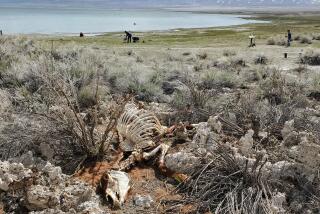New Light Shed on Cavemen and Killing of Horses
- Share via
BOSTON — For more than a century, anthropologists have painted a vivid picture of the prehistoric events that occurred at the killing ground of Solutre in east-central France.
From 37,000 years ago until 12,000 years ago, scientists said, groups of cave dwellers regularly drove herds of wild horses up a long slope and over a cliff, where they plunged to their death. The humans then ate the meat of the horses and collected their skins for clothing and other uses.
The site is marked by a 2.5-acre burial ground containing the bones of tens or even hundreds of thousands of horses, the largest such collection in Europe.
New Interpretation
That picture is indeed dramatic, but it is also almost certainly wrong, anthropologist Sandra L. Olsen of Johns Hopkins University in Baltimore said here at a meeting of the American Assn. for the Advancement of Science.
The new interpretation of the evidence at the site, she said, is giving a much better picture of how early man behaved.
A growing body of evidence indicates that the horses were, in fact, rounded up in a corral-like cul-de-sac at the base of the slope about 900 feet from the cliff face, Olsen said in a report made Sunday.
The hunters may have placed rocks and debris around the cul-de-sac to lessen the likelihood that the horses would escape. Then the hunters dispatched the horses with spears, butchered them, and ate their kill. The bones were then cast aside and buried by soil washing down from the slope.
Choicest Cuts
And the cave dwellers must have been fairly good at their task, Olsen said. She could find very few butchering marks on the bones when she examined them under an electron microscope. This suggests that the hunters opted for only the choicest cuts of meat, she said, and did not have to scrape the last remnants of flesh from the bones.
The earlier theory that horses were driven off the cliff probably stemmed from studies of North American Indians, who did use that strategy to hunt buffalo. But Olsen’s review of studies of wild horses and zebras indicate that the strategy would not be likely to work with horses.
Horses normally travel only in small groups, she said, they are more agile than buffalo and they are very aggressive when cornered or threatened.
But the most convincing evidence, she said, is that “absolutely no remains have been found at the base of the sheer cliff.” It is exceptionally unlikely, she argued, that the cave dwellers would have moved entire horses 900 feet to the bone site before butchering them.
Modern Clues
Studies of modern hunter-gatherers in Africa indicate, she said, that the horses would have been butchered at the site where they were killed, and only the best portions of the carcasses taken to a camp or cave for further processing.
Olsen noted that the bone burial site is only a short distance from a natural passageway by which the horses would have migrated between the flood plain of the Saone River and the eastern foothills of the Massif Central every spring and fall.
The cave dwellers would have had to divert the horses only about 900 feet to the cul-de-sac. That could have been accomplished with as few as 25 people, she said. In contrast, driving them over the cliff would have required a diversion of well over a mile, and a much larger number of people.
Studies of the horses’ teeth, she noted, indicate that they died during the spring, summer and fall, which is consistent with the theory that they were killed while migrating.
Implied Talents
“Although this new hypothesis may appear less dramatic than the image of horses leaping off a precipice to their death, it nonetheless demonstrates a considerable understanding (by the cave dwellers) of animal behavior and a level of social organization capable of conducting a communal hunt,” Olsen said.
“It also implies a certain amount of scheduling on the part of the hunters in order to arrive in the valley at the appropriate time of year to intercept the migrating bands of horses.”
More to Read
Sign up for Essential California
The most important California stories and recommendations in your inbox every morning.
You may occasionally receive promotional content from the Los Angeles Times.










